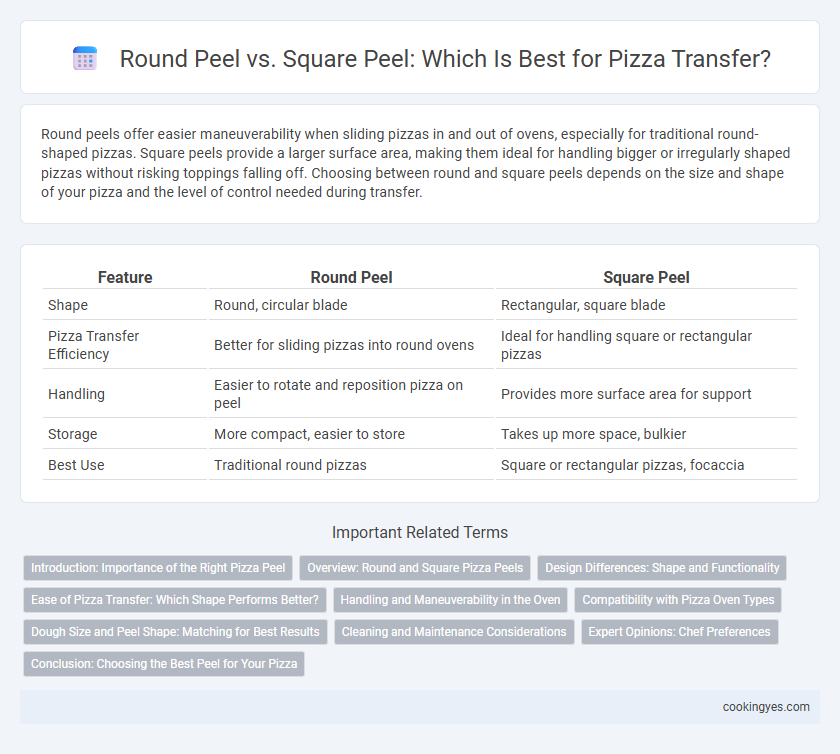Round peels offer easier maneuverability when sliding pizzas in and out of ovens, especially for traditional round-shaped pizzas. Square peels provide a larger surface area, making them ideal for handling bigger or irregularly shaped pizzas without risking toppings falling off. Choosing between round and square peels depends on the size and shape of your pizza and the level of control needed during transfer.
Table of Comparison
| Feature | Round Peel | Square Peel |
|---|---|---|
| Shape | Round, circular blade | Rectangular, square blade |
| Pizza Transfer Efficiency | Better for sliding pizzas into round ovens | Ideal for handling square or rectangular pizzas |
| Handling | Easier to rotate and reposition pizza on peel | Provides more surface area for support |
| Storage | More compact, easier to store | Takes up more space, bulkier |
| Best Use | Traditional round pizzas | Square or rectangular pizzas, focaccia |
Introduction: Importance of the Right Pizza Peel
Choosing the right pizza peel significantly impacts the efficiency and safety of transferring pizzas in high-temperature ovens. Round peels, typically crafted for easy maneuverability, excel at sliding pizzas in and out of narrow oven openings, while square peels offer a larger surface area that supports and stabilizes dough during transfer. Selecting between a round or square peel depends on oven type, pizza size, and baker preference, ensuring optimal handling and preventing toppings from shifting or falling.
Overview: Round and Square Pizza Peels
Round pizza peels offer excellent maneuverability and ease of sliding under dough, ideal for traditional hand-tossed pizzas due to their curved edge that helps scoop from the oven surface. Square pizza peels provide a larger surface area, making them suitable for handling bigger or rectangular pizzas and improving stability during transfer. Both types are typically crafted from wood or aluminum, with wooden peels reducing dough sticking and metal peels ensuring durability and heat resistance.
Design Differences: Shape and Functionality
Round pizza peels feature a circular design that mimics the shape of pizzas, providing smooth and precise transfers by allowing easy rotation under the dough. Square peels have a flat, rectangular surface that offers more room to support larger or multiple pizzas, enhancing stability during transfer. The choice between round and square peels depends on the desired control, maneuverability, and pizza size handling in a professional or home kitchen setting.
Ease of Pizza Transfer: Which Shape Performs Better?
Round pizza peels excel in ease of pizza transfer due to their continuous, curved edge, allowing for smooth sliding under dough without snagging. Square peels provide a larger surface area, offering better support for oversized or irregularly shaped pizzas, but their sharp corners can catch on the oven floor or pizza edges. Overall, round peels often perform better in seamless pizza transfer, especially for traditional round pizzas.
Handling and Maneuverability in the Oven
Round peels offer superior maneuverability due to their curved edges, allowing easier rotation and placement of pizzas within tight oven spaces. Square peels provide a larger surface area, enhancing stability when transferring pizzas but can be less agile in confined oven environments. Handling round peels requires precise wrist movements for smooth sliding, while square peels demand careful alignment to avoid scraping or damage during transfer.
Compatibility with Pizza Oven Types
Round peels are ideal for traditional wood-fired and deck ovens due to their easy maneuverability inside round oven chambers, enabling precise pizza placement and retrieval. Square peels offer greater surface area and are better suited for conveyor and rectangular ovens, providing ample support for larger pizzas and easier handling during transfers. Both peel types must match oven dimensions and heating style to ensure efficient pizza baking and safe transfer.
Dough Size and Peel Shape: Matching for Best Results
Choosing the right peel shape directly affects dough transfer efficiency: round peels perfectly match circular dough, preventing edges from drooping during transfer, while square peels offer a wider surface ideal for larger or irregularly shaped doughs, providing greater support. For consistently sized pizzas, round peels minimize the risk of dough sticking or deformation by evenly supporting the entire crust circumference. Square peels, conversely, excel in handling oversized or custom-shaped dough, reducing spillage and ensuring smooth maneuvering across the oven deck.
Cleaning and Maintenance Considerations
Round pizza peels typically have fewer corners and crevices, making them easier to clean and less prone to food buildup compared to square peels. Square peels can trap dough and toppings in their corners, requiring more thorough scrubbing and maintenance to prevent residue and potential bacterial growth. Materials like wood or aluminum impact the cleaning process, with aluminum peels generally easier to sanitize and less absorbent than wooden ones.
Expert Opinions: Chef Preferences
Expert chefs often prefer round peels for their ease in rotating pizzas inside wood-fired ovens, enhancing even cooking and crust development. Square peels are favored for efficiently transferring larger or rectangular pizzas, providing greater surface area and stability during handling. Many professionals recommend selecting peel shape based on pizza size and oven type to optimize transfer precision and cooking results.
Conclusion: Choosing the Best Peel for Your Pizza
The choice between a round peel and a square peel for pizza transfer hinges on personal preference and baking style, with round peels offering superior maneuverability for rotating pizzas, especially in tight oven spaces. Square peels excel in sliding pizzas onto and off the oven surface due to their larger surface area, making them ideal for handling bigger or multiple pizzas. Ultimately, selecting the best peel depends on oven size, pizza dimensions, and user comfort, ensuring efficient and precise pizza transfer.
Round peel vs Square peel for pizza transfer Infographic

 cookingyes.com
cookingyes.com